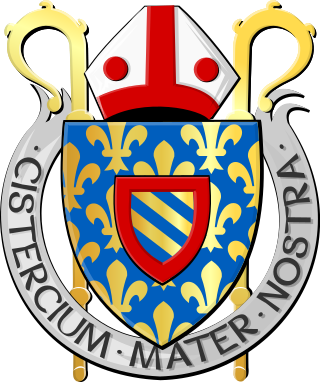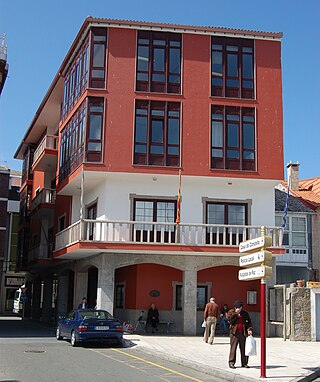
A monastery is a building or complex of buildings comprising the domestic quarters and workplaces of monastics, monks or nuns, whether living in communities or alone (hermits). A monastery generally includes a place reserved for prayer which may be a chapel, church, or temple, and may also serve as an oratory, or in the case of communities anything from a single building housing only one senior and two or three junior monks or nuns, to vast complexes and estates housing tens or hundreds. A monastery complex typically comprises a number of buildings which include a church, dormitory, cloister, refectory, library, balneary and infirmary, and outlying granges. Depending on the location, the monastic order and the occupation of its inhabitants, the complex may also include a wide range of buildings that facilitate self-sufficiency and service to the community. These may include a hospice, a school, and a range of agricultural and manufacturing buildings such as a barn, a forge, or a brewery.

The Cistercians, officially the Order of Cistercians, are a Catholic religious order of monks and nuns that branched off from the Benedictines and follow the Rule of Saint Benedict, as well as the contributions of the highly-influential Bernard of Clairvaux, known as the Latin Rule. They are also known as Bernardines, after Saint Bernard himself, or as White Monks, in reference to the colour of the "cuculla" or cowl worn by the Cistercians over their habits, as opposed to the black cowl worn by Benedictines.

The Tironensian Order or the Order of Tiron was a medieval monastic order named after the location of the mother abbey in the woods of Thiron-Gardais in Perche, some 35 miles west of Chartres in France). They were popularly called "Grey Monks" because of their grey robes, which their spiritual cousins, the monks of Savigny, also wore.
In Christianity, an oblate is a person who is specifically dedicated to God and to God's service.

Subiaco is a town and comune in the Metropolitan City of Rome, in Lazio, central Italy, 40 kilometres (25 mi) from Tivoli alongside the river Aniene. It is a tourist and religious resort because of its sacred grotto, in the medieval St. Benedict's Abbey, and its Abbey of Santa Scolastica. It is a member of the I Borghi più belli d'Italia association. The first books to be printed in Italy were produced here in the late 15th century.

The Schottenstift, formally called Benediktinerabtei unserer Lieben Frau zu den Schotten, is a Catholic monastery founded in Vienna in 1155 when Henry II of Austria brought Irish monks to Vienna. The monks did not come directly from Ireland, but came instead from Scots Monastery in Regensburg, Germany. Since 1625, the abbey has been a member of the Austrian Congregation, now within the Benedictine Confederation.

Pforta, or Schulpforta, is a school located in Pforta monastery, a former Cistercian monastery (1137–1540), near Naumburg on the Saale River in the German state of Saxony-Anhalt.

Muxía is a coastal town and municipality in the province of A Coruña in the autonomous community of Galicia in northwestern Spain. It belongs to the comarca of Fisterra. It is one of the final destinations for pilgrims on the Way of St. James after visiting the shrine of the apostle Saint James the Great in Santiago de Compostela.

Fleury Abbey (Floriacum) in Saint-Benoît-sur-Loire, Loiret, France, founded in about 640, is one of the most celebrated Benedictine monasteries of Western Europe, and possesses the relics of St. Benedict of Nursia. Its site on the banks of the Loire has always made it easily accessible from Orléans, a center of culture unbroken since Roman times. In 2010, the abbey had over forty monks led by the abbot Etienne Ricaud.

Humbert of Maroilles was a Frankish monk, abbot, and saint. He founded Maroilles Abbey.

Snelshall Priory was a Benedictine priory in Milton Keynes, Buckinghamshire in the United Kingdom, built around 1200. The priory was founded after Sybil d'Aungerville granted land at Tattenhoe to Lavendon Abbey, a Premonstratensian monastery of 'White canons' who most likely started a cell at Snelshall. This did not thrive and was abandoned about 1207. About 1219, the founder's son brought in Benedictine monks, increased the endowment and the new monastery began again. However Snelshall Priory paid 1 mark a year to Lavendon until 1232, at which point the Bishop of Lincoln decided that Snelshall owned its own lands and chapel. The priory accumulated various land through gifts, but even with all these grants, in 1321 when Henry Burghersh visited, it was so poor that "the monks scarcely had the necessities of life and had to beg even for these".

Magloire, better known as Saint Magloire of Dol, is a Breton saint. Little reliable information is known of Magloire as the earliest written sources appeared three centuries after his death. These sources claim that he was a monk from Wales who became the Bishop of Dol-de-Bretagne in Brittany during the 6th century, and ended his life on the island of Sark, where he was abbot of a monastery.
Pelayo Rodríguez was the Bishop of Iria Flavia (977–985). He was a son of the powerful magnate Rodrigo Velázquez and his wife Adosinda and is usually associated with the conflicts surrounding the accession of Vermudo II after a Galician rebellion in 982.

The Monastery of San Pedro de Villanueva is a Catholic religious complex located in Villanueva de Cangas, in Cangas de Onis, Asturias, Spain.

Cono was a Benedictine monk. He was born in Diano (Italy) in the late 12th century, and became a monk in S.Maria di Cadossa Benedictine Monastery near Montesano sulla Marcellana. He died very young in the early years of the 13th century with a reputation for holiness. When Cadossa monastery was closed his relics were returned to Diano in 1261, where he is venerated as its patron saint.

Gómez Núñez was a Galician and Portuguese political and military leader in the Kingdom of León. His power lay in the valley of the Minho, mainly on the north side, bounded by the Atlantic on the west and corresponding approximately with the Diocese of Tui. There, according to a contemporary source, he had "a strong site, a fence of castles and a multitude of knights and infantry."

The Monastery of San Xulián de Samos is an active Benedictine monastery in Samos, Galicia, Spain. It was founded in the sixth century.

The monastery of San Martiño Pinario was a Benedictine monastery in the city of Santiago de Compostela, Galicia, Spain. It is the second largest monastery in Spain after San Lorenzo de El Escorial.

The Santa Cueva de Nuestra Señora de Covadonga is a Catholic sanctuary located in Asturias, northern Spain. It is a cave in the Picos de Europa mountains, which gives its name to the parish of Covadonga in the municipality of Cangas de Onís. The name refers to the sanctuary, dedicated to the Virgin of Covadonga, where the first battle of the Spanish Reconquest took place in 718.

Sant Miquel del Fai is a cenobitic Benedictine monastery in Bigues i Riells, Catalonia, Spain. The 11th-century building was declared a Bien de Interés Cultural landmark in 1988.


















